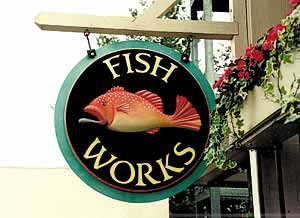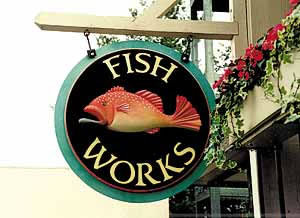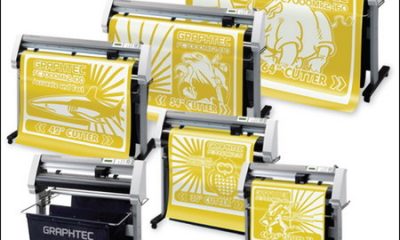Sparky Potter, proprietor of Wood & Wood Signs (Waitsfield, VT), considers using renewable materials a priority. He said, “Wood is in our shop’s name, so I think promoting the most natural materials possible is important,” Potter said. “I emphasize the use of local products whenever possible to reduce fuel consumption and transportation costs. I think it’s my job to educate the customer about the environmental footprint of all project phases – materials, hardware, lighting, you name it – and let them make an informed decision.”
Resourceful thinking enabled energy-efficient production of signage for Moonlight Basin, a Montana resort. He learned of a recently demolished cedar barn in the area and successfully reclaimed sufficient panels to fabricate the sign panel. He also found a woodworking company less than 25 miles away to fabricate the signposts.
Earlier this year, Burlington, VT-based Seventh Generation contacted Wood & Wood to fabricate architectural signage for its headquarters. Because the city’s sign code forbade vinyl, Wood & Wood crafted dimensional signage. For the building’s exterior, Potter and his staff fashioned panels from MDO, mahogany, maple, glass and aluminum. Inside, they installed ceiling-hung placards with maple brackets that comprise frosted glass decorated with a high-resolution, digital paper print between layers.
Brian Hart, vice president of sales and marketing for Ivey (Seattle), which fabricates signage for retail environments, vigorously pursued greener materials after learning more about the subject at a conference a few years ago. Initially, his pursuit of suppliers knowledgeable about green products proved futile but, eventually, he forged relationships with like-minded vendors. Hart spearheaded a four-point checklist that verifies a supplier’s compliance:
• Materials can be recyclable, but the vendor must verify an established recycling program or network and outline what materials could be made from the repurposed material;
Advertisement
• Products identified as biodegradable must carry documentation verifying the claim,
• Products made with post-consumer waste content must document the percentage; and
• Materials made with renewable energy create carbon offsets (credits purchased to invest in carbon-reduction materials).
Ivey recently developed signage and graphics for REI, the hiking- and outdoor-gear superstore. Befitting their earthy image, REI asked Ivey to fabricate display boards made from 100% post-consumer recycled stock. After considerable effort, Ivey found a mill that produced 0.48-in.-thick composite-material board. The shop printed the boards on an EFI-VUTEk PV 200 UV-ink flatbed printer.
Robert Flannery III, vice president of sales for White Way Sign Co. (Mt. Prospect, IL), is the fourth generation of his family to oversee the company’s operations. The company produces numerous scoreboard and messageboard display signs, and the conversion from incandescent to LED-powered displays has allowed operators to consume 90% less electricity. Moreover, Flannery said the development of stronger alloys and better CAD/CAM and engineering software and methods have reduced the amount of steel or aluminum required for construction of its casino, entertainment and retail signage. Also, the company harvests all of its scrap material and forwards it to appropriate vendors.
Flannery also lauds LEDs’ energy efficiency and lifespan as catalysts for customers’ significant energy savings. A few years ago, British Petroleum (BP) hired White Way to assist BP’s rebranding by redesigning its canopy graphics.
Advertisement
“They were adamant that the new solution had to offer greater energy efficiency, so we installed green LED strips that formed a border around the canopy,” Flannery said. “BP contracted to place solar panels on top of the canopies to harvest energy and further reduce the energy required to power the border.”
White Way also emphasized energy conservation when it moved into its new facilities in May. In lieu of incandescent lamps, the company fully incorporated CCFL fluorescent bulbs, which Flannery predicts will help the shop consume 90% less electricity while requiring fewer replacements.


 Tip Sheet1 week ago
Tip Sheet1 week ago
 Photo Gallery3 days ago
Photo Gallery3 days ago
 Ask Signs of the Times5 days ago
Ask Signs of the Times5 days ago
 Real Deal2 weeks ago
Real Deal2 weeks ago
 Benchmarks1 week ago
Benchmarks1 week ago
 Photo Gallery10 hours ago
Photo Gallery10 hours ago
 Paula Fargo10 hours ago
Paula Fargo10 hours ago
 Women in Signs2 weeks ago
Women in Signs2 weeks ago









